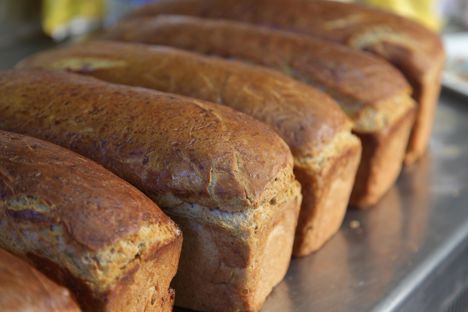Bread has been made in one form or another for thousands of years. The first breads were un-leavened (made without yeast) and would have been similar to the tortillas commonly associated with Mexican food today. The Egyptians discovered the properties of yeast around 3000BC and began adding it to bread to make it rise. Grain made it to Britain around this time with barley, wheat and rye being grown but it wasn't until the Romans introduced the water mill that bread became a staple food in the British diet.
Thousands of years later, bread began to be mass produced and, with the invention of the Chorleywood bread process in 1961, it could be made very quickly and cheaply – this is the bread we most commonly eat today. In recent years, however, there has been an upsurge in the number of artisanal bakeries as people are moving away from eating highly processed foods in preference for traditionally made breads with natural, organic ingredients.
There are many different types of bread that vary with region, process and grain used. The French traditionally eat baguettes but are also associated with brioche, boule, pain de mie and fougasse to name but a few. Then there is Italian ciabatta, focaccia and pannetone, Indian chapati, naan and paratha, Greek pita, Turkish pide . . . the list is endless. The UK is not particularly famous for bread, mostly taking inspiration from the rest of the world with sourdoughs, rye breads and baguettes commonly found in bakeries nationwide.
How to make bread
The most basic ingredients for baking bread are simply flour, water and salt which are mixed together and left to ferment for a number of days to form a starter. The starter is then ‘fed’ with fresh flour every couple of days to keep it ‘alive’ (fermenting). This is a lengthy process, favoured by bakers making deep flavourful sourdough breads as the longer the fermentation process the stronger the flavour of the resulting bread. This starter is then used to make loaves of bread with a strong ‘sour’ flavour. Some bakers have starters that are many years old.
Bread can be made much more quickly with the addition of yeast, whether it be dried or fresh. The yeast kick-starts the fermentation process allowing bread to be made in a few hours rather than a few days. All the ingredients are mixed together, kneaded and left to ferment, known as the Bulk Fermentation Process. The bread is then shaped as desired and proofed again before cooking.
Different flours can be used in bread production resulting in very varying flavours, the most common being white wheat flour and wholemeal wheat flour as these contain the most gluten.
To ensure a good, thick crust is formed most breads need to be baked at a very high temperature in the region of 220°c or above, however this is not true of enriched doughs (doughs that contain butter) as they will burn at these high temperatures.
Finally it is important to leave the bread to cool sufficiently before diving in and slicing. Breaking into the bread while it is still hot will result in a huge loss of steam and will render the loaf dry and undesirable, be patient and you will be rewarded.
What bread goes with
Bread can be part of, or accompany any meal, any time of the day. Whether its egg and soliders for breakfast, a BLT sandwich for lunch, or pizza for dinner bread is normally involved in day to day life. Making bread at home is time consuming, but very rewarding. Dominic Chapman give us his recipe for white bread, but it doesn’t have to stop there, bread can be flavoured with herbs, spices, cheese, olives, there are many possiblites. Try Lee Wescotts’s Rosemary brioche, Emily Watkins Potato bread or Marcello Tully’s beetroot bread for something a little different. Bread also features in many sweets from the humble bread and butter pudding to Paul A Young's delectable Chocolate, ginger and cardomom tea bread.
Get in touch
Please sign in or register to send a comment to Great British Chefs.



